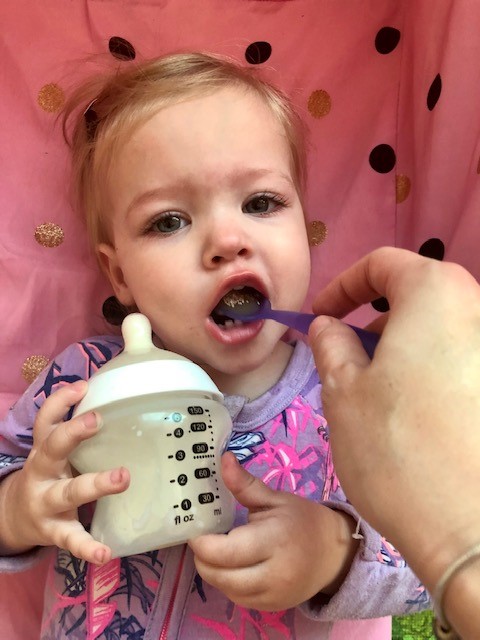Pancreatic Function
Around 90% of babies with CF will have issues with their pancreas, which is known as pancreatic insufficiency. Babies who are pancreatic insufficient will need Pancreatic Enzyme Replacement Therapy (PERT) when they eat food or drink nourishing fluids (e.g. milk) to allow their body to break down food and absorb nutrients. Without PERT, pancreatic insufficient babies are at risk of poor nutrient absorption leading to poor weight gain.
The small percentage of babies whose pancreas functions normally are known as pancreatic sufficient. These babies will not require enzymes but will be routinely assessed during their regular hospital appointments.
Enzyme Storage
- Store Creon at room temperature ~15°C to 25°C. Avoid heat.
- You may store Creon at a temperature between 25°C to 40°C for up to 30 days. Throw away any Creon that has been stored at these temperatures for more than 30 days.
- Keep Creon in a dry place and in the original container.
- After you open the bottle, keep it closed tightly between uses to protect against moisture.
- Keep Creon out of the reach of children.
Enzyme Dosages
The most common enzymes used in Australia are called Creon and they will need to be taken with all milk feeds. The dose of enzymes is based on how many grams of fat is in the feed.
Your dietitian will advise you on individual enzyme recommendations for your baby, however a rough guide is one scoop of Creon Microspheres (Creon 5,000) per 4g of fat.
- For newborns that are breast feeding, they will often start with ½ a scoop of Creon with every breast feed.
- For those that are bottle fed, the Creon dose will be matched to the volume of milk your baby is having at a feed. A rough guide is 1 scoop of Creon per 110ml of infant formula.
- Babies that have started solids will have approximately one scoop of Creon per 4 g of fat. More information on solids is available here.
The PCH dietitian will adjust the Creon dose over time based on your baby’s weight, feed volumes and symptoms of malabsorption.
What If I Forget to Give My Baby Enzymes?
Don’t panic if you forget to give your baby enzymes. There is a lot to focus on just feeding your baby, let alone having to include medication into the picture. There is nothing drastic that can happen if enzymes are forgotten during a feed, other than possibly some extra runny poos. However, if enzymes are not given regularly over a period of time, your baby will experience weight loss.
Administering Enzymes
The thought of giving your baby enzymes can feel overwhelming at the start, but it will soon become very normal. Your baby’s dietitian will support you throughout the process and provide plenty of education.
A Brief Guide for Enzyme Administration is:
Deliver enzymes at the start of every feed. They are only effective for 30 minutes, so if a feed takes longer than this, extra enzymes will be required.
- Mix enzymes with a small amount of apple or pear puree (~1/4 tsp). This is important as the acidity of the fruit will aid absorption of the medication.
- Administer with a soft baby spoon.
- If your baby spits out the mixture, gently scoop it back into their mouth until the whole dose is consumed.
- Be sure to wipe away any granules left around their mouth as they can cause ulcers if left on the skin. This can be done with a large cotton tip or small flannel dipped in sterile water.
- Some babies may get nappy rash from using enzymes. A barrier cream applied liberally at each nappy change will help prevent this.
Malabsorption
It is important to learn the warning signs that your child is having problems digesting their food. If you notice these signs, your baby should be reviewed by their dietitian.
Signs of Malabsorption are:
- Tummy pain, excessive wind and discomfort – in babies this may include squirming or tensing up muscles as well as facial expressions such as squeezing eyes shut or grimacing.
- Very bad smelling bowel movements
- Greasy, oily bowel movements
- Diarrhoea and/or constipation
- Nappy rash
- Ulcers in the mouth or bottom
- Hunger despite feeding well/eating lots of food
- Poor weight gain and/or growth
Weight gain is a good indicator of how well the enzymes are working and if your baby is digesting and absorbing the feeds.
Enzymes & Breast Feeding
Work with your baby’s CF care team to work out a routine that works well for you and your baby. You might try different enzyme dosing options, such as spreading the enzyme dose throughout the feed e.g. half the dose at the beginning of the feed and the other half when changing sides or if baby takes a break. It can take a bit of practice and getting to know your baby’s feeding patterns before getting the enzyme administration exactly right. Your baby will be ok while you work this all out and get to know each other.
When babies start sleeping through the night, your milk supply will be greater and your baby may have a bigger feed first thing in the morning, so extra enzymes may be needed.
Using Enzymes Out & About
Getting out of the house with a new baby can be daunting, especially with enzymes to consider, but this too will get easier with time. Many families pack a cooler bag with the enzymes, soft baby spoon and the apple or pear puree. You can also add a flannel for wiping any enzymes left on their face. You can make your own puree at home and freeze into small portions (such as an ice cube tray), or puree pouches are convenient, especially when out. However, remember these need to be refrigerated once opened, so ensure you use a cooler bag with an ice brick.
Nutrition Pack
You can collect a CFWA Nutrition Pack from the PCH dietitian, which includes a cooler bag and brick, containers for mixing, spoon, apple puree and a Nutrition Diary to record your baby’s current medication dosages and to keep track of their daily intake of milk, Creon (if required), salt and multivitamin.
